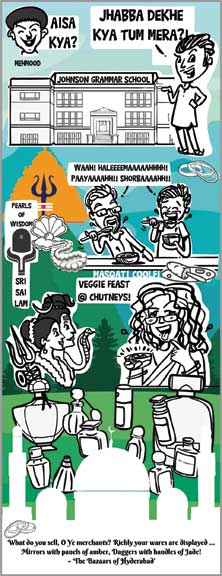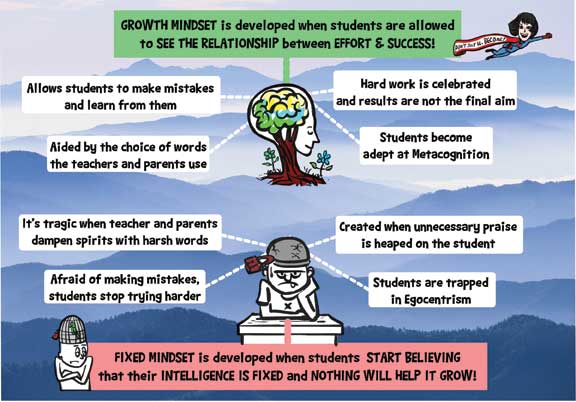Devika Nadig
The journey of a thousand miles began with the launch of Shikshangan in 2008 and continued much beyond this distance by covering the length, breadth and depth of our country. In the course of these journeys and the many interactions they brought, Vijay and I learned from individuals, communities and multiple stakeholders in the education landscape. I reckoned it would make sense to share these experiences with a wider audience, with the aim of documentation and a hope that these will both entertain and educate. Each tour was unique and I hope my storytelling skills will amuse and not lose – readers.
Some of our travels took us to ancient temple towns, creating the opportunity for encounters that made me confront my own ambiguous relationship with religion, but in the process, led me to interesting discoveries – about myself and my teaching practice.
Eighth Stop – Sarojini Naidu – Mecca Masjid – Srisailam-Hyderabad – 2017
What do you sell, O Ye merchants? Richly your wares are displayed …Mirrors with panels of amber, Daggers with handles of Jade – Nightingale of India, Sarojini Naidu in ‘The Bazaars of Hyderabad’

In childhood, Bollywood’s Mehmood with his funny accent was the quintessential Hyderabadi for us, until carefree youth introduced me to the tinkling ‘Bangle Sellers’ of Sarojini Naidu (1879 to 1949), poetess and sister of Harindranath Chattopadhyay another poet and Bollywood icon, both, of course, being freedom fighters in India’s struggle for freedom. This fascinating city seemed very distant then, but I soon bridged the gap by marrying a Hyderabadi whose Hindi – “Jhabba dekhe kya tum mera?” – had me wonder whether he was asking for a ‘jhola’ or a ‘dabba’.. before reckoning he meant a kurta!
Having heard a great deal about the Grammar School of Hyderabad where the father of my children had studied in his early years, I was excited to get an invitation from Johnson Grammar School for a 10 day training camp, only to discover that this was a different group of schools, ‘Grammar’ being a popular prefix for schools in the region. A suffix that Hyderabad schools seem to love is ‘Techno’, claiming to prepare students for the IIT and nothing else. Did you think you’ve got choice?
Johnson Grammar is led by the suave Dr. Chandrashekhar Rao and his efficient team. Worthy of mention is Poonam Agarwal, who planned 10 modules over several phone calls with us and ensured a steady flow of dialogue before, during and after the sessions. This is where Shikshangan first introduced the idea of the Growth Mindset brought to light into the world of education by Carol Dweck. Her seminal work throws a torch on what makes students develop a mental framework that is always geared towards putting in more effort for achieving success, viz a viz – the Fixed Mindset that does not allow you to learn and grow. How we speak to our children matters. What they end up interpreting from our feedback can create the damaging Fixed Mindset, or then if you are aware of Dweck’s work, your feedback will create the success oriented Growth Mindset.
Summer days were filled with endless sessions and evenings were delicious with the immeasurable fragrance of Hyderabad – in real scent as well. Rao’s daughter dreamt of starting a perfume business then, having completed her course in perfumery in Paris; and she taught us how blends are created by top perfumers of the world in the bylanes of Charminar, by mixing portions of essential oils and ittar. Intriguingly, you find almost the same perfume as you would find in fancy Dior or Channel, Estee Lauder or Prada bottles, in these narrow alleys because this is where they are blended … the other center being Kannauj in Uttar Pradesh. Hyderabad has the genuine pearls and perfumes, the Gadhwal and the Ikkat, the wisdom of brotherhood and the aroma of tolerance – and you need to discover it, without getting lost in fake news, fake glitter and glamour of the dazzling lac bangles of Lad Bazaar.
We were in the midst of Ramzan, and what better then embracing the maddening crowds of shoppers of tinsel trinkets and roadside epicurean delights? Vijay had a field day with a young teacher, Shravan, as both of them stopped at every joint and tasted some hedonistic stuff called Haleem, a dish introduced by the Nizams. During Ramzan, they beat the already dead meat to absolute death and then cook it on a very slow flame for hours to torture it further, before it finds its way to craving tongues and stomachs, religion and culture no bar! I would hide behind the jangle-bangle stalls emerging only to see satiated expressions on the faces of the men who were with us, women strangely abstaining. Who said we have evolved? The cave man exists within us!
To douse the fires, we first gorged on the famous and delicious Masqati Kulfi and then headed to the exquisite Jewel of Nizam restaurant, a must-stop for classic Mughal cuisine, where all the understated refinement of an era gone by surrounds you as you are waited upon by men and women dressed in Nizam haute couture. I looked feverishly for a vegetarian recipe while my carnivorous companions guzzled ‘Paya Shorba’. Finding none, I took a trip all around the refurbished palace, gazing on gorgeous replicas of the famous jewels. A balm to my senses after the razzle dazzle of Charminar.
In an attempt at atonement, another evening was spent in the culinary delight for herbivorous grass-eaters like me – the ubiquitous ‘Chutneys’. I refrain from mentioning what you can drool on as a vegetarian here, hoping that this teaser will help you explore the place yourself and never regret it.

When did Ramzan change to Ramadan? Whichever way you pronounce it, our experience of this festive period wouldn’t have been complete without a walking tour to the Mecca Masjid close-by. Built during the Qutb Shahi dynasty, it is said to contain bricks brought from Mecca, hence its name. This is one of the largest congregation mosques in India; the fountains in the expansive courtyards were tranquil and serene, as we reached after the evening prayer, thus being afforded the luxury of sitting by the waters that seemed to be offering ibadat themselves, with faithful iman. Exposed to Urdu poetry from my early years, Ghalib rung in my heart with …
hairan hoon tujhe masjid mein dekh kar ghalib
aisa bhi kya hua jo khuda yaad aa gaya?
Taking these treasures of experience with us, far richer than the Nizam’s wealth, we drove away from it all, on a beauteous road to Srisailam. Escorted by Imran Bhai (our driver for the day), courtesy – close friend Sai Leela – a trainer for Satya Sai Schools, we went over hills and valleys, with the Krishna river flowing placidly alongside, through the lush and dense Nallamala forest, popular for adventure sports and forest research.
Faith moves mountains as the adage goes, and I was moved to tears on setting my eyes on Srisailam Mallikarjunam, the only Jyotirlng which has Shiva and Shakti together; this being the second Shakti Peetha I prayed at after Kamakhya. Shakti Peethas are shrines where Sati’s body parts/ornaments fell on earth, as Shiva danced his Rudra Tandav – as the legend goes. As word of this life-giving combined temple of Shiva and Shakti spreads throughout the surrounding villages, towns and beyond, people make pilgrimages from all over the world – to see her, if possible to touch her, and ultimately as in all places of worship – to ask for one’s wellbeing.
We humanize what is going on in the world and in ourselves by speaking of it, and I suppose that makes us more human. Between Ramzan and Shiva, there lay a world between people, and though the world is concerned about this in-between, I found something magical in this space, a special kind of humanity; manifesting itself in friendship as well as fraternity in the animated conversation with Imran Bhai about both, the Mecca Masjid and the Mallikarjunam shrine. Personal faith never was a hindrance to this sharing of what both of us had experienced in all our years of being believers of sorts, neither of us intensely practicing!
What I most rue about the Internet is that, for all its readily accessible information, it has changed the colour and texture of human curiosity, deadening and often killing that wondrous feeling of learning about the thing you hadn’t known – you didn’t know – but now greatly enjoy knowing, by explorations on the ground with humans so distant from your own comfort zone.
Deen and Aqueedah that pulsated loudly in Charminar, was a silent Bhakti and Aastha in my meditation here.
The author has been engaged in the domain of school education for the past three decades. She is the co-founder of Shikshangan Education Initiatives, Pune, along with Vijay Gupta. The scope of their work includes teacher development by sharpening pedagogical skills and working with school leaders on their instructional and organizational leadership skills. She can be reached at devika@shikshangan.org.
